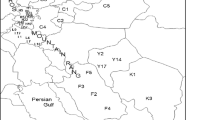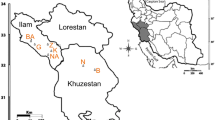Abstract
Genetic variation in three populations of Parkia timoriana (DC.) Merr. grown in the Manipur state of northeast India was analysed using inter-simple sequence repeat (ISSR) markers. A total of 30 individual trees representing three populations were sampled and studied using 22 University of British Columbia (UBC set no. 9) primers in the present study. Of the total 22 primers, 19 primers produced distinct, reproducible and well-resolved fragments. Overall, a total number of 111 fragments were generated by the 19 primers and of which, 51 were polymorphic (45.94 %). The average number of loci and polymorphic loci generated per primer were 5.84 and 2.68, respectively. The genetic variation generated by ISSR markers within the three populations studied ranges from 33.33 to 18.92 %. The overall genetic differentiation (Gst) among populations was estimated to be 0.29, and the number of gene flow (Nm) was estimated to be 1.23 per generation between populations. Of the total genetic variance, 70.04 % was attributed to within-population diversity while 4.72 % differences to the among-populations. The genetic similarity across the individuals belonging to the three populations was represented by the dendrogram showing the grouping of the individuals into three major groups which is also supported by the principle component analysis. The present finding asserts the effectiveness of ISSR procedure for assessing genetic variations of P. timoriana populations and provides valuable genetic information that can be utilized for breeding and conservation strategies.


Similar content being viewed by others
References
Schaal, B. A., & Learn, G. H. (1988). Annals of the Missouri Botanical Garden, 75, 1202–1216.
Hamrick, J. L., Godt, M. J. W., Murauski, D. A., & Lordess, M. D. (1991). In D. A. Falk & K. E. Holsinger (Eds.), Genetics and conservation of rare plants: implications for conservation biology (pp. 75–86). New York: Oxford University Press.
Rogers, D. L., & Ledig, F. T. (1996). Genetic Resources Conservation Program, Report No. 16. Davis, CA: University of California.
Namkoong, G. (1997). Paper for FORGEN News. Rome, Italy: International Plant Genetic Resources Institute (IPGRI).
Hopkins, H. C. F. (1994). Kew Bulletin, 49, 182–234.
Kanjilal, U. N., Kanjilal, P. C., & Das, A. (1982). Flora of Assam. Delhi: Avon.
Longvah, T., & Deosthale, Y. G. (1998). Food Chemistry, 62, 477–481.
Suvachittanont, W., Kurashima, Y., Esumi, H., & Tsuda, M. (1996). Food Chemistry, 55, 359–363.
Meitei, W. I., & Singh, A. I. (1990). Indian Journal of Hill Farming, 3, 47–49.
Salam, J. S., & Singh, S. B. (1997). Indian Journal of Hill Farming, 10, 115–118.
Avise, J. C. (1976). In F. J. Ayala (Ed.), Molecular evolution: genetic differentiation during speciation (pp. 106–122). Sunderland, MA: Sinnauer.
Gupta, P. K., & Varshney, R. K. (2000). Euphytica, 113, 163–185.
Avise, J. C., Bowen, B. W., & Lamb, T. (1989). Molecular Biology and Evolution, 6, 258–269.
Thangjam, R., Damayanti, M., & Jitendra, G. S. (2003). Journal of Food Agriculture and Environment, 1, 46–49.
Suwannarat, K., & Nualsri, C. (2008). Songklanakarin Journal of Science and Technology, 30, 433–440.
Parsons, B. J., Newbury, H. J., Jackson, M. T., & Ford-Lloyd, B. V. (1997). Molecular Breeding, 3, 115–125.
Chowdhury, M. A., Vandenberg, B., & Warkentin, T. (2002). Euphytica, 127, 317–325.
Goulao, L., & Oliveira, C. M. (2001). Euphytica, 122, 81–89.
Zietkiewicz, E., Rafalski, A., & Labuda, D. (1994). Genomics, 20, 176–183.
Kantety, R. V., Zeng, X., Bennetzen, J. L., & Zehr, B. E. (1995). Molecular Breeding, 1, 365–373.
Godwin, I. D., Aitken, E. A. B., & Smith, L. W. (1997). Electrophoresis, 18, 1524–1528.
Archak, S., Gaikwad, A. B., Gautam, D., et al. (2003). Genome, 46, 362–369.
Thangjam, R., Damayanti, M., & Jitendra, G. S. (2003). Journal of Food Agriculture and Environment, 1, 36–38.
Nei, M. (1978). Genetics, 89, 583–590.
Yeh, F. C., Yang, R. C., Boyle, T. B., et al. (1997). POPGENE ver. 1.32, the user-friendly shareware for population genetic analysis. Canada: Molecular Biology and Biotechnology Center, University of Alberta.
Excoffier, L., Smouse, P. E., & Quattro, J. M. (1992). Genetics, 131, 479–491.
Rohlf, F. J. (2000). NTSYS-pc ver. 2.2a numerical taxonomy and multivariate analysis system. New York: Exeter Software.
Nei, M. (1972). American Naturalist, 106, 283–292.
Weir, B. S. (1996). Methods for discrete population genetic data. Sunderland, MA: Sinauer Assoc., Inc.
Hamrick, J. L., Linhaart, Y. B., & Mitton, J. B. (1979). Annual Review of Ecology, Evolution, and Systematics, 10, 173–200.
Nevo, E., Beiles, A., & Ben-Shlomo, R. (1984). In G. S. Mani (Ed.), Lecture notes in biomathematics, vol. 53: evolutionary dynamics of genetic diversity (pp. 13–123). New York: Springer.
Loveless, M. D., & Hamrick, J. L. (1984). Annual Review of Ecology, Evolution, and Systematics, 15, 65–95.
Hamrick, J. L., & Godt, M. J. W. (1989). In A. H. D. Brown, M. T. Clegg, A. L. Kahler, et al. (Eds.), Plant population genetics, breeding and genetic resources: allozyme diversity in plant species (pp. 43–63). Sunderland, MA: Sinauer Press.
Bussell, J. D. (1999). Molecular Ecology, 8, 775–789.
Li, H. S., & Chen, G. Z. (2004). Acta Ecologica Sinica, 24, 1656–1662.
Slatkin, M. (1985). Annual Review of Ecology, Evolution, and Systematics, 16, 393–430.
Acknowledgments
The author gratefully acknowledge the Department of Biotechnology (DBT), Ministry of Science and Technology and Government of India for the award of postdoctoral fellowship and Prof. M. Rohinikumar Singh (Ex-Director, Institute of Bioresources and Sustainable Development, Imphal, India) for providing necessary facilities for the experiment.
Author information
Authors and Affiliations
Corresponding author
Rights and permissions
About this article
Cite this article
Thangjam, R. Inter-Simple Sequence Repeat (ISSR) Marker Analysis in Parkia timoriana (DC.) Merr. Populations from Northeast India. Appl Biochem Biotechnol 172, 1727–1734 (2014). https://doi.org/10.1007/s12010-013-0639-7
Received:
Accepted:
Published:
Issue Date:
DOI: https://doi.org/10.1007/s12010-013-0639-7




